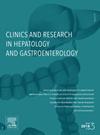Emergent endoscopy is associated with lower mortality in hemodynamically unstable upper GI bleeding: single-center experience with 24/7 endoscopy services
IF 2.4
4区 医学
Q2 GASTROENTEROLOGY & HEPATOLOGY
Clinics and research in hepatology and gastroenterology
Pub Date : 2025-03-31
DOI:10.1016/j.clinre.2025.102580
引用次数: 0
Abstract
Background and Aims
The effectiveness of emergent endoscopy (EE), defined as endoscopy performed within six hours of admission, for improving outcomes in patients presenting with acute upper gastrointestinal bleeding (AUGIB) remains controversial. This study aimed to evaluate the impact of EE on 42-day rebleeding and mortality rates and identify subgroups of patients who benefit most from this approach.
Methods
We conducted a retrospective cohort study at a tertiary hospital with 24/7 endoscopy services. Eligible patients were aged ≥18 years, presented with AUGIB, and underwent endoscopy within 24 hours of admission. The exclusion criteria included prior interventions at other facilities, in-hospital bleeding for unrelated reasons, or loss to follow-up. All patients were managed under a standardized AUGIB protocol. The primary outcomes were 42-day rebleeding and mortality. The data were analysed via multivariate logistic regression and interaction analyses.
Results
There were 651 patients with a median age of 58.6 years (18–92). The median time from admission to endoscopy was 4.8 hours (3.1–8.0). The 42-day rebleeding and mortality rates were 16.7% and 11.8%, respectively. EE was significantly associated with 42-day mortality but not rebleeding. Independent risk factors for mortality included hemodynamic instability, malignancy, NSAID use, and elevated serum creatinine. Interaction analysis revealed that EE was associated with reduced 42-day mortality in hemodynamically unstable patients (OR: 0.29, 95% CI: 0.145–0.579), a benefit not observed in patients with other risk factors for mortality.
Conclusion
EE appears to be associated with reduced 42-day mortality in patients presenting with hemodynamically unstable AUGIB.
急诊内窥镜检查与血流动力学不稳定的上消化道出血的低死亡率相关:24/7内窥镜服务的单中心经验。
背景和目的:急诊内镜(EE)的有效性,定义为入院后6小时内进行的内镜检查,以改善急性上消化道出血(AUGIB)患者的预后仍存在争议。本研究旨在评估EE对42天再出血和死亡率的影响,并确定从该方法中获益最多的患者亚组。方法:我们在一家提供24小时内镜检查服务的三级医院进行了回顾性队列研究。符合条件的患者年龄≥18岁,出现AUGIB,并在入院24小时内行内镜检查。排除标准包括以前在其他机构的干预,院内出血的无关原因,或失去随访。所有患者均在标准化AUGIB方案下进行管理。主要结局为42天再出血和死亡率。通过多元逻辑回归和交互分析对数据进行分析。结果:651例患者,中位年龄58.6岁(18-92岁)。从入院到内镜检查的中位时间为4.8小时(3.1-8.0)。42天再出血和死亡率分别为16.7%和11.8%。EE与42天死亡率显著相关,但与再出血无关。死亡的独立危险因素包括血流动力学不稳定、恶性肿瘤、使用非甾体抗炎药和血清肌酐升高。相互作用分析显示,EE与血流动力学不稳定患者的42天死亡率降低相关(OR: 0.29, 95% CI: 0.145-0.579),这一益处在具有其他死亡危险因素的患者中未观察到。结论:EE似乎与血流动力学不稳定的AUGIB患者的42天死亡率降低有关。
本文章由计算机程序翻译,如有差异,请以英文原文为准。
求助全文
约1分钟内获得全文
求助全文
来源期刊

Clinics and research in hepatology and gastroenterology
GASTROENTEROLOGY & HEPATOLOGY-
CiteScore
4.30
自引率
3.70%
发文量
198
审稿时长
42 days
期刊介绍:
Clinics and Research in Hepatology and Gastroenterology publishes high-quality original research papers in the field of hepatology and gastroenterology. The editors put the accent on rapid communication of new research and clinical developments and so called "hot topic" issues. Following a clear Editorial line, besides original articles and case reports, each issue features editorials, commentaries and reviews. The journal encourages research and discussion between all those involved in the specialty on an international level. All articles are peer reviewed by international experts, the articles in press are online and indexed in the international databases (Current Contents, Pubmed, Scopus, Science Direct).
Clinics and Research in Hepatology and Gastroenterology is a subscription journal (with optional open access), which allows you to publish your research without any cost to you (unless you proactively chose the open access option). Your article will be available to all researchers around the globe whose institution has a subscription to the journal.
 求助内容:
求助内容: 应助结果提醒方式:
应助结果提醒方式:


